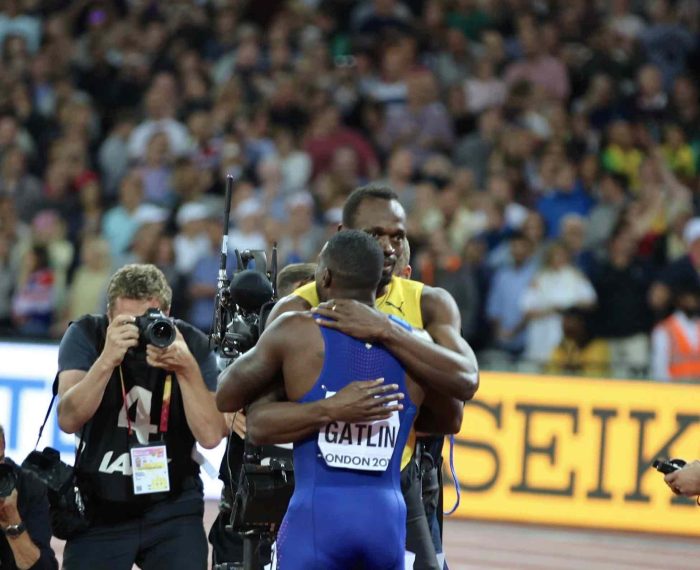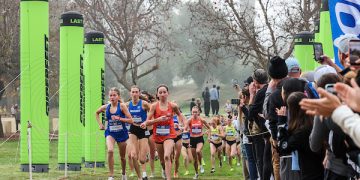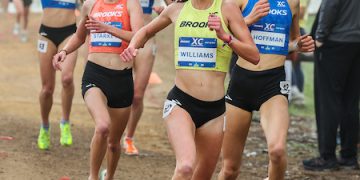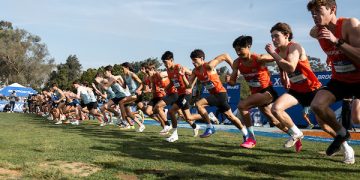Deji Ogeyingbo shook up some of our readers a few weeks ago with his column on Sha’Carri Richardson. This column is about the opportunity that Deji believes has been wasted, so far, in not working with Usain Bolt to help build the global brand of World Athletics.
World Athletics has not done enough to milk the brand of Usain Bolt
On August 16, 2008, inside the Bird’s Nest stadium in Beijing, Usain Bolt won his first Olympic Gold medal. The Jamaican, then 21, was already the world record holder but lowered the mark to 9.69 seconds, easing clear of his rivals and celebrating before he crossed the line. Even as the Bolt eased up to celebrate midrace and stroke that pose—one that would become synonymous with his eventual countless wins, his dominance in the race was in no way affected as he etched his name in history.
A star was born on that day. Well, figuratively. Athletics had waited patiently for the once-in-a-lifetime athlete to pop up. Bolt answered the call. From the time he turned pro in 2003, and even past his last major victory at the Rio Olympics in 2016, Bolt drew more eyes to him and his sport than any other sprinter ever. In his prime, Bolt turned races into must-watch events, even for those who had never watched an athletics event before.
He was mesmeric, a perfect blend of talent and charisma suited for a growing sport that had been tainted with many drugs-related issues for athletes. TV ratings, galleries, and prize money all increased significantly. People had to watch. Bolt transcended the sport, one which a lot of people had given up on. He brought life into it.
His appeal was just astonishing. In 2013, Forbes made his debut at Number 48 on Forbes’s annual Celebrity 100 list, based on fame and money. He became the first track star to achieve such.
When Bolt rose to dominance, the world suddenly saw athletics as admirable. Hardcore fans have long understood the appeal of the sport, but that doesn’t mean that teenage boys have always gotten that. But at the height of Bolt’s career, everyone – even Gen Z’s – wanted to be Bolt.
Some of the top sprinters of the last few years, such as Yohan Blake, Letsile Tebogo and Wayde Van Niekerk cite Bolt as one of their major inspirations as they were growing up. Bolt helped take athletics to a new level, and they wanted to join him at those heights.
For most athletics fans, the theatrics and decibels of Bolt’s performance were too much. But TV ratings, ticket sales and corporate interest in the sport indicate that far more fans — including newly minted fans — flocked to his races. He brought an element of entertainment to the sport — first, just on his pure dominance, physical prowess, and pure determination.
Even among everyday players, Bolt made the sport cool. A sport whose athletes were to be admired. Although Bolt has since retired, his fanbase hasn’t dwindled. The Jamaican participated in various exhibition tournaments, dabbled in football, released a record label, and attends many promotional events.
However, in all of his contributions to the sport, there is a growing feeling the sport did not leverage the popularity of the big Jamaican to the fullest during his hay day and even after retirement, World Athletics haven’t come up with sustainable strategies to continue to push the brand of Bolt in the face of people.
The majority of global sports have been able to take advantage of the popularity of some marquee athletes in their sport to grow their popularity of it in different regions or penetrate a different market using various strategies. Not so for athletics.
Tiger Woods changed how we watched golf, the NBA made the most of Michael Jordan’s popularity, Serena Williams inspired young black girls through her dominance of women’s Tennis, and at the peak of their powers, FIFA used the sporting prowess of Pele and Maradona to transform the game in myriad ways.
For example, the first Nike TV commercials in 1996 to introduce Woods to viewers were “Hello, World” and “I am Tiger Woods.” Each told stories. The first was about his commitment to golf and his road to the tour. The second is his roots and connection to a new, diverse generation.
His celebrity status preceded him. Woods appeared on the sidelines at NFL and basketball games. He played golf with Jordan, Charles Barkley and Tony Romo. He hung with Mark Cuban, Michael Phelps, Jon Bon Jovi, Sting, and Will Ferrell. It all brought more attention to golf and the tournaments he played. And with it, more people followed the sport.
The title of the World’s fastest man is one that would follow Bolt as long as he lives. It is an accolade usually reserved for the Olympic or World champion in the men’s 100m. But there have been many of those since Bolt retired, yet he continues to bear the moniker. It’s what branding and making people see you through the eyes of the sport does. Bolt is an enigma. He still is, at least for a few decades to come.
At the peak of his powers, his celebrity status saw him throttle the globe meeting celebrities in all works of life. Prince Harry and Kevin Hart were in a race with him, the President of the United States Barack Obama did his lightning Bolt celebration, and he dinned with football stars in Europe. In short, he made everyone like athletics again.
There is a growing feeling that the marketing team at Puma, whom Bolt signed as a teenager didn’t capitalize fully on his brand and come up with marketing strategies that would outlive his time on the track. The world record in the men’s 100m was set in Puma shoes. The world didn’t really notice.
For example, Nike’s ‘Air Jordan’ campaign was so successful that the shoe giants continued to milk the NBA for all they were worth. Throughout the seasons that Jordan competed in the shoes, they ran a commercial that spotlighted Jordan. The camera ran slowly down his body, from his head to his feet, and once they hit his shoes, “a big “X” was stamped on the screen,” (FTLTG). The announcer thereafter said, “banned”. It didn’t matter. After his retirement, the NBA still associates itself with the brand as it helped improved its popularity.
World Athletics have not done enough to maximize the “Bolt effect” on and off the track. Granted they are preoccupied with organizing competitions, taking care of athletes, and ensuring the purity of the sport. All of that is good but not when you realize they have ignored the biggest of them all. Marketing. And to a larger extent, ignoring their biggest marketing tool, Bolt.
Since 2017 when Bolt retired, the Jamaican has been to Formula One races, big football matches, and a couple of other sporting events. No Olympics or world championships. It sounds absurd, right? The governing body of World Athletics has not deemed it fit to bring into the fray the biggest name to emerge from the sport so as to continue to inspire the younger audience and increase their popularity.
One thing is certain. If the conservative nature of the sport doesn’t explore daring marketing strategies to grow athletics, there is an increasing possibility for it to continue to decline in global acceptability as seen from the numbers since 2017 when Bolt stopped competing. Bolt generated a kind of excitement around athletics that was unprecedented and nothing was done about it.
Author
-

Deji Ogeyingbo is one of Nigeria’s leading Track and Field Journalists as he has worked in various capacities as a writer, content creator, and reporter for radio and TV stations in the country and Africa. Deji has covered varying degrees of Sporting competitions within and outside Nigeria which includes, African Championships and World Junior Championships. Also, he founded one of Nigeria’s leading Sports PR and Branding company in Nikau Sports in 2020, a company that aims to change the narrative of how athletes are perceived in Nigeria while looking to grow their image to the highest possible level.
View all postsRelatedPosts























